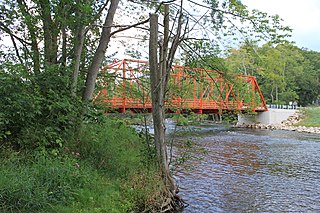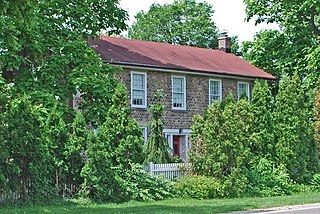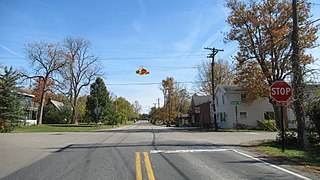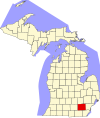
Washtenaw County is a county located in the U.S. state of Michigan. At the 2020 census, the population was 372,258. The county seat and largest city is Ann Arbor. The county was authorized by legislation in 1822 and organized as a county in 1826. Washtenaw County comprises the Ann Arbor Metropolitan Statistical Area. The county is home to the University of Michigan, Eastern Michigan University, Washtenaw Community College, and Concordia University Ann Arbor.

Ann Arbor Charter Township is a charter township of Washtenaw County in the U.S. state of Michigan. The population was 4,673 at the 2020 census. The township borders the city of Ann Arbor and contains numerous exclaves, but the two are administered autonomously.

Dexter is a city situated in Washtenaw County, Michigan, in the United States. As of the 2020 United States census, the city's population was recorded at 4,500.

The Huron River is a 130-mile-long (210 km) river in southeastern Michigan, rising out of the Huron Swamp in Springfield Township in northern Oakland County and flowing into Lake Erie, as it forms the boundary between present-day Wayne and Monroe counties. Thirteen parks, game areas, and recreation areas are associated with the river, which passes through the cities of Dexter, Ann Arbor, Ypsilanti, Belleville, Flat Rock and Rockwood that were developed along its banks.
There were several historic mills around the metro Atlanta area, for which many of its current-day roads are still named. Most of the mills date back to the 1820s and 1830s, and were built along the area's many streams. The locations of many of these mills are shown on a map of 1875 showing U. S. military operations around Atlanta in 1864. This map is now located in the U. S. Library of Congress but can be seen on the webpage linked here.

Watson's Mill is an historic flour and gristmill in Manotick, Ontario, Canada. It is the only working museum in the Ottawa area and one of the very few operating industrial grist mills in North America. Watson's Mill still sells stone-ground whole wheat flour which is made on site. The mill is also well known for its ghost Annabelle. The legend is that Ann Currier, wife of Joseph, haunts the mill, following her death in a tragic accident there in 1861. Watson's Mill is Manotick's most recognized landmark. Its image is used as a symbol for the village.
Historic Mill Creek, formerly known as Historic Mill Creek State Park and Historic Mill Creek Discovery Park, is a state park, nature preserve, and historic site in the United States state of Michigan. It is run by Mackinac State Historic Parks, the operating arm of the Mackinac Island State Park. 625 acres (2.5 km2) in size, the park is located 5 miles (8 km) southeast of Mackinaw City, Michigan on U.S. Highway 23.

Babcock State Park is a state park located along the New River Gorge on 4,127 acres (16.7 km2) wooded in Fayette County, West Virginia. It is located approximately 20 miles away from the New River Gorge Bridge.

Kirby's Mill is a historic grist mill in Medford, Burlington County, New Jersey, United States. Originally known as Haines Mill, it was built in 1778 by Isaac Haines and partners along the Southwest Branch of Rancocas Creek. It was the last commercial operating mill in New Jersey.

Delhi Metropark is a park in the Huron-Clinton system of metro parks. It is an 81-acre (330,000 m2) park on the Huron River located five miles (8 km) northwest of Ann Arbor. It has picnic areas, two picnic shelters, swings and slides, river fishing, canoe rental and softball diamonds. A children's playground features an adventure playship, ride-on toys and swings. A Metropark daily or annual vehicle permit is required for entry to the park. The park will eventually be linked to Dexter-Huron Metropark and Hudson Mills Metropark via the Border-to-Border Trail.

The Cobblestone Farm and Museum, which includes the Dr. Benajah Ticknor House is an historical museum located at 2781 Packard Road in Ann Arbor Michigan. The museum gets its name from the cobblestone used to build the farmhouse. It was listed on the National Register of Historic Places in 1972 and designated a Michigan State Historic Site in 1973.
The Border-to-Border (B2B) Trail is a partially constructed non-motorized trail in Washtenaw County, Michigan. The trail is planned to cover approximately 35 miles (56 km) from Livingston County to Wayne County along the Huron River.

Henry Ford's Village Industries were small factories located in rural areas of Michigan. Ford developed his Village Industries in part to provide farm workers a stable source of income during the winter months.

Gordon Hall, also known as the Judge Samuel W. Dexter House, is a private house located at 8341 Island Lake Road in Dexter, Michigan. It was designated a Michigan State Historic Site in 1958 and listed on the National Register of Historic Places in 1972. The house is unique in Michigan for its balance, large scale, and massive hexastyle portico. The structure is also significant as the dwelling of Judge Samuel W. Dexter, a pioneering Michigan resident and land baron who had a substantial impact on early development of Washtenaw County and other sections of the state. The house was later owned by Dexter's granddaughter Katharine Dexter McCormick, a pioneering research scientist, suffragist, and philanthropist. In its early days, Gordon Hall hosted at least two, and possibly three United States presidents, and it was almost certainly a stop along the Underground Railroad.

Benson Grist Mill is a restoration-replica museum located in Tooele County, Utah in the western United States, which allows visitors to see the inner workings of a latter-nineteenth-century pioneer gristmill. It has four other historic (nineteenth-century) buildings which have been moved onto the site, as well as four ancillary structures, including an open-air pavilion. It covers 6.98 acres along State Highway 138, 0.8 mile southwest of the intersection of the Road with State Highway 36. The museum is owned and operated by a division of Tooele County.

The Orrin White House, also known as the Orrin and Ann Thayer White House or the Robert Hodges Residence, is a private house located at 2940 Fuller Road in Ann Arbor, Michigan. It was designated a Michigan State Historic Site in 1970 and listed on the National Register of Historic Places in 1971.

Nelson Meade County Farm Park is a 141-acre public park in eastern Ann Arbor, Michigan owned by Washtenaw County and operated by the county's Parks and Recreation Commission. Consisting of a mix of woodlands, fields, and gardens, the park is home to a wide variety of flora and fauna and is a popular local destination for gardening, hiking, jogging, and biking. The park has been county land since 1836, although for the majority of the nineteenth and twentieth centuries it was used as the county's poorhouse and then as its infirmary. In 1972, the site began transitioning to parkland with the creation of community gardens, and over the next couple decades various trails and a perennial garden were created. Since 2000, the park has experienced significant ecological restoration efforts, including the removal of invasive plants, prairie restoration, and the creation of a wet meadow during the restoration of Malletts Creek.

The Grist Mill Bridge, Dam and Mill Site consists of three structures located along Upton Road between Island Road and the Maple River, one-half mile west of Elsie, Michigan in Duplain Township. The three structures are:

Mooreville is an unincorporated community in Washtenaw County in the U.S. state of Michigan. The community is located within York Township. As an unincorporated community, Mooreville has no legally defined boundaries or population statistics of its own.


























